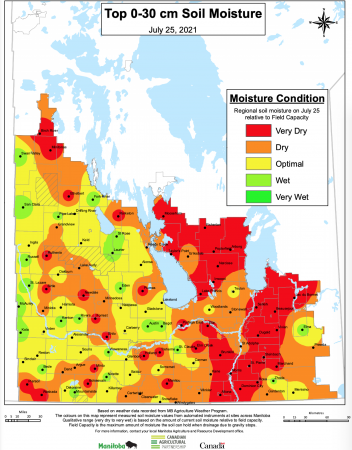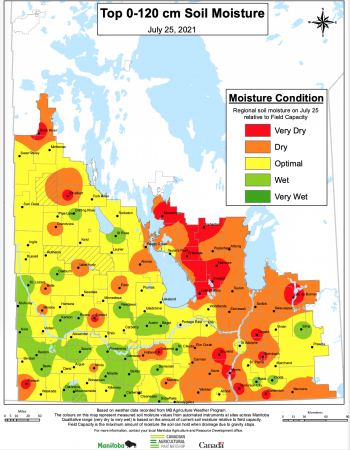
News
Emerging Trends
Prairie producers asked to contact provincial corps. before repurposing crops as feed
July 28, 2021 By Top Crop Manager
Saskatchewan
As of July 19, crops remain extremely stressed from the lack of moisture and continue to advance quickly due to the heat and dry conditions. Crop yields have already been damaged, but any rain received will maintain yields through the heat.
Many cereal crops that have headed out are not developing kernels; some producers have elected to cut these crops as greenfeed. As there is a significant shortage of livestock feed, Saskatchewan Agriculture is encouraging producers to consider alternate uses for crops that will not develop.
Provincial crop development, as of July 19
| % ahead | % normal | % behind | |
| Fall cereals | 44 | 51 | 5 |
| Spring cereals | 37 | 52 | 11 |
| Oilseeds | 36 | 50 | 14 |
| Pulse crops | 43 | 49 | 8 |
Crop damage this week was attributed to localized hail, strong winds, lack of moisture, heat and grasshoppers. Many producers are assessing the benefit of spraying for grasshoppers in fields that are very poor in condition and are considering cutting them as greenfeed.
In response to the feed shortage this year, Saskatchewan Crop Insurance Corporation is doubling the Low Yield Appraisal threshold values for customers who salvage their cereal or pulse crops as feed, without negatively impacting future individual coverage. Customers are asked to contact their local SCIC office before they graze, bale or ensile any damaged crops to discuss their options.
Additionally, the Government of Saskatchewan is making changes to temporarily increase the maximum funding a livestock producer can receive from the Farm and Ranch Water Infrastructure Program (FRWIP) for dugouts, wells and pipelines for agricultural use. This change will be in effect for the April 1, 2021, to March 31, 2022, time period. |READ MORE
Manitoba
As of July 27, drought conditions persist; most crops are seeing downgraded yield expectations. Eleven rural municipalities have declared an Agricultural State of Disaster in the past week, in addition to the four which made the declaration last week. Producers are asked to contact the Manitoba Agricultural Services Corporation (MASC) before putting crops to alternate use.
Percentage of crop by region rated good to excellent for July 19-27*
| Southwest | Northwest | Central | Eastern | Interlake | |
| Barley | 60 | 70 | – | – | – |
| Canola | 55 | 50 | – | 10 | 5 |
| Corn | – | – | – | 25 | 15 |
| Dry beans | – | – | 55 | – | – |
| Flax | – | – | – | 20 | – |
| Oats | 50 | 70 | 20 | 10 | – |
| Peas | 75 | 55 | 70 | 10 | – |
| Soybeans | 75 | – | – | 50 | 20 |
| Spring wheat | 60 | 70 | 25 | 50 | 5 |
| Sunflowers | 70 | – | 75 | 80 | 15 |
*Crops with – indicate insufficient data; or crop acreage is not significant in that region.
Manitoba Agriculture and Resource Development (MARD) has changed the style of soil moisture map reporting for the remainder of 2021 to more accurately reflect the extreme drought conditions in Manitoba. The soil moisture mapping will be relative to field capacity rather than saturation, as was previously the case. Mapping based on field capacity allows us to better depict the differences in water availability based on soil texture under dry conditions. Water-holding capacity varies greatly by soil texture – sandier soils retain water more poorly than loam or clay soils. |READ MORE
 |
 |